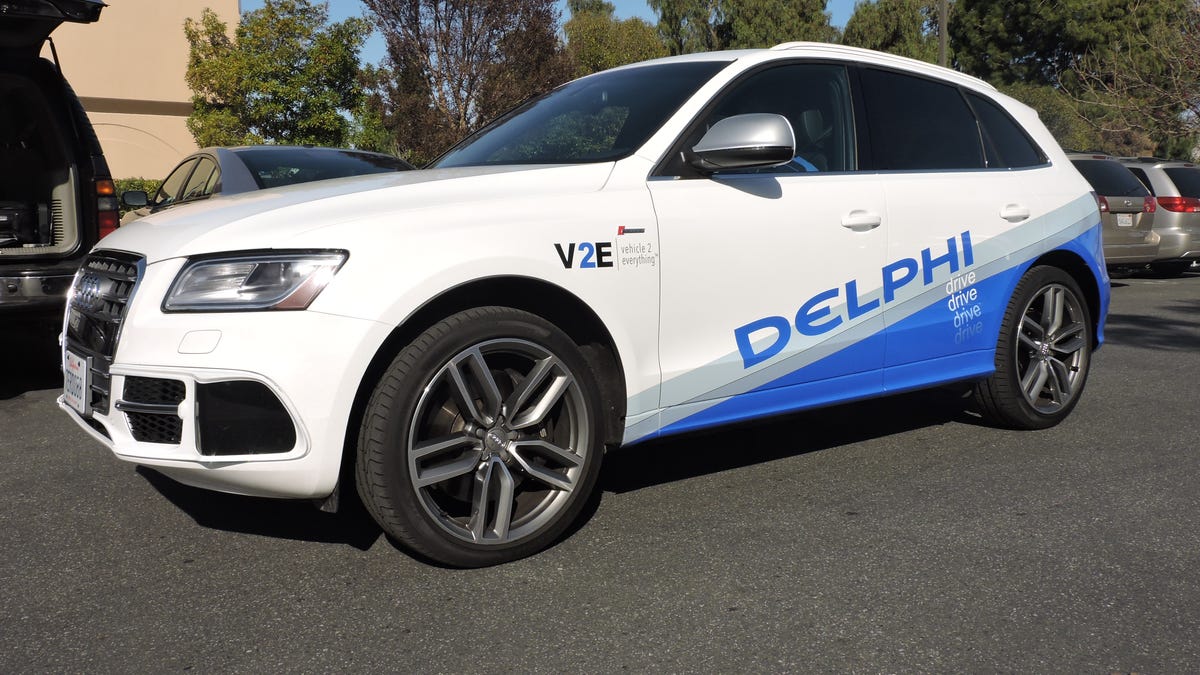Delphi's self-driving car is Audi this world
It may not reach everyday drivers anytime soon, but Delphi's Vehicle to Everything technology can already pilot an Audi SQ5.

A soothing voice came out of the speakers, "Delphi Drive available." The human behind the car's wheel pushed a button on the center console, and just like that, the car had a mind of its own.
Now driverless, the Audi SQ5 approached a green light. To its left was a double yellow line. To its right, where I was sitting, was a rather large 18-wheeler, parked on the side of the road.
Delphi has turned an Audi SQ5 into an autonomous vehicle...and it works.
The Audi cared not for the large hunk of parked metal and proceeded to whiz by, at the posted speed limit, of course, leaving mere inches between the large Mack truck and my window.
I probably should have taken a Xanax before getting in.
The Audi was being driven by automotive parts supplier Delphi's new Vehicle to Everything (V2E) technology, which connects cars to the world around them. "Everything" includes traffic lights, streets, signs, other cars and even pedestrians themselves.
V2E goes way beyond just keeping the car within a lane and controlling speed. The technology means the car can respond to other drivers' wacky behavior (yes, even when that jerk cuts you off at the toll plaza). The V2E-equipped Audi can also anticipate traffic-light status and plan for the most efficient speed. And what of those folks who walk around with their noses buried in their cell phones? Although this Audi wasn't set up for it, V2E can communicate with smartphones and warn the driver of any distracted walkers in the area.
Our buddy Tom requesting a ride.
Nandita Mangal, leader of the driver experience effort at Delphi, handed me an iPad before my ride commenced. As the Audi toddled along, the iPad showed what I could do on my route. For example, I could use it to tell the car to pull over at Starbucks or to stop and pick up my friend "Tom" who was using Delphi's proposed ride-sharing technology to monitor my whereabouts and request a ride. He's always been a moocher, that Tom.
We didn't actually make these detours, mind you. It was merely a programmed highlight to show me what V2E would be capable of.
At one point, we even got on the highway...for one exit. No merging or lane change was required but the Audi kicked its way up to 55 mph in no time and left the highway without incident.
Delphi is constantly running edge scenarios to make its technology smarter. But until those cases are complete, which will take years, a real live human must remain behind the wheel at all times. During our time on the road, my....um...I guess we'll call him my technology minder remained silent behind the wheel. He didn't touch the controls but was ready to do so at any moment.
Frankly I don't know how he stopped himself from putting the hammer down on the supercharged SQ5. Regardless of the speed of traffic around you, the autonomous car follows the speed limit. While maximum speed in downtown Palo Alto is anywhere from 25 to 35 miles an hour, drivers routinely travel at much higher speeds, making it almost embarrassing to be inside the V2E Audi. Just think, at some point soon you'll probably be behind some slow-poke computer driven vehicle, yelling, "Get your CPU out of your butt and drive!"
Drive, drive, drive...autonomously.
Perhaps what surprised me the most was how quickly I got used to the car doing its own thing. Granted, I was a passenger and I might have been a little more worried if I were sitting in the driver's seat. It wasn't long, however, before I had completely accepted seeing the steering wheel whip around on its own. Once I accepted it as reality, it was easy to focus on Nandita as she explained the technology from the backseat.
Delphi says full urban autonomous driving won't be available for five or even 10 years. Let's just hope the technology, like Delphi's, will still let us humans take over when we want. Driving is too much fun to leave it all to computers.

